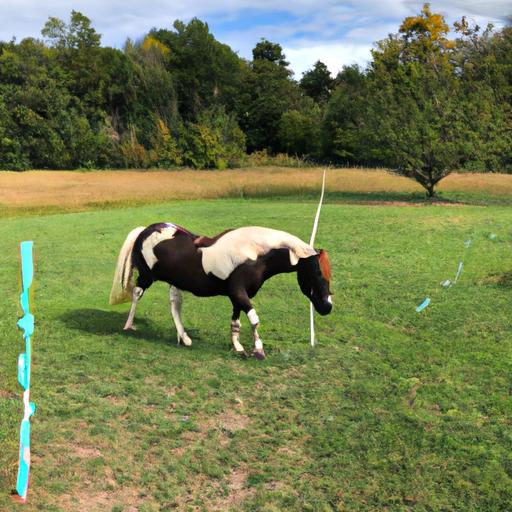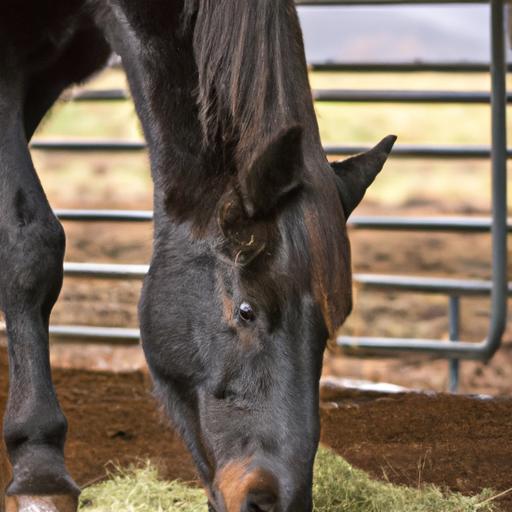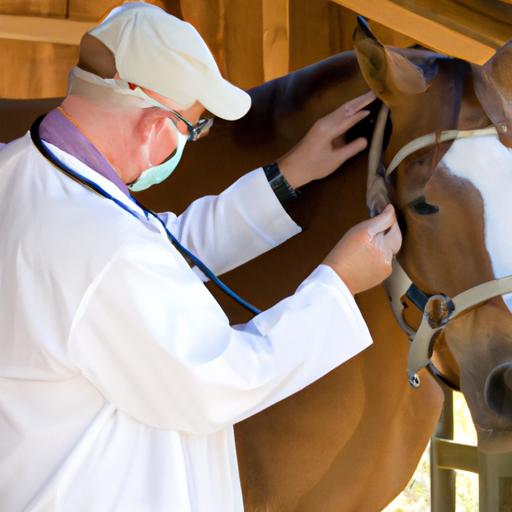Discover the essential nutrition and feeding guidelines for blind horse care. Learn how to meet their unique dietary needs and establish a consistent feeding routine.
Introduction to Blind Horse Care

Imagine a world without sight, where darkness reigns supreme and every step is uncertain. Now, extend this imagery to our beloved equine companions. Blind horses, just like their human counterparts, face unique challenges that require careful attention and specialized care. In this article, I will guide you through the intricacies of blind horse care, shedding light on the importance of providing them with the utmost care and understanding.
When it comes to blind horse care, ensuring their well-being goes beyond simply fulfilling their basic needs. These remarkable animals require a nurturing environment that caters to their specific requirements, allowing them to thrive despite their visual impairment. By understanding the challenges blind horses face, we can create a safe and fulfilling life for them.
One of the key reasons blind horse care is crucial is the vulnerability blind horses experience daily. Without their sight, they rely heavily on their other senses, such as touch, hearing, and smell, to navigate the world around them. Any sudden changes or obstacles in their environment can cause distress and potential harm. Therefore, it is our responsibility to create a safe and secure space that minimizes the risks they face.
Blind horse care involves implementing various strategies to ensure their safety and well-being. From designing a secure pasture with tactile markers and barriers to establishing consistent feeding routines, every aspect of their care must be meticulously planned. By doing so, we can provide these magnificent creatures with the stability they need to flourish.
In the upcoming sections, we will delve deeper into the specific aspects of blind horse care, equipping you with the knowledge and tools necessary to create a nurturing environment. Together, let’s embark on this journey of compassion and empathy, as we uncover the secrets to caring for our blind equine companions.
Stay tuned for Section 2, where we will explore the art of creating a safe environment for blind horses, ensuring their physical and emotional well-being.
Creating a Safe Environment

Ensuring a Secure and Well-Maintained Pasture for Blind Horses
When it comes to blind horse care, a secure and well-maintained pasture is paramount. Providing a safe environment for our visually impaired equine friends ensures their physical and emotional well-being. Here are some essential steps to consider:
- Fencing and Enclosure: Start by assessing the fencing around the pasture. Ensure it is sturdy, well-maintained, and free from any sharp edges or protruding objects that may pose a risk to blind horses. Regular inspections and repairs are crucial to prevent accidents.
- Obstacle-Free Zones: Create designated obstacle-free zones within the pasture to minimize the chances of blind horses colliding with objects. Remove any unnecessary clutter, such as fallen branches, rocks, or equipment, that may obstruct their path.
- Consistent Layout: Blind horses thrive on familiarity and routine. Maintaining a consistent layout within the pasture can help them navigate their surroundings with ease. Avoid frequent changes in the arrangement of objects or structures to prevent confusion and disorientation.
Installing Tactile Markers and Barriers to Aid Navigation
To assist blind horses in navigating their environment, the installation of tactile markers and barriers proves invaluable. These aids provide sensory cues that help them orient themselves and avoid potential hazards. Consider the following:
- Fence Markers: Attach brightly colored or reflective markers to the fence at regular intervals. These markers create a contrast against the surroundings, making it easier for blind horses to detect and follow the fence line.
- Gates and Entryways: Marking gates and entryways with unique textures or scents can help blind horses identify and locate these access points. Using different textures such as ropes, ribbons, or wind chimes can provide valuable tactile and auditory cues.
- Obstacle Markers: For objects within the pasture that cannot be removed, use tactile markers such as rubber mats or textured surfaces to indicate their presence. These markers act as warning signals, allowing blind horses to navigate around them safely.
By implementing these measures, we can create a secure and accessible environment for blind horses. In Section 3, we will explore the crucial aspect of nutrition and feeding guidelines for these remarkable equine companions.
Establishing a Routine and Consistency

The Significance of Routine in Blind Horse Care
Just like humans, blind horses thrive on routine and consistency. Establishing a predictable schedule not only provides them with a sense of security but also helps them navigate their daily activities with ease. Consistency in their care routine can significantly reduce stress and anxiety, allowing them to adapt and flourish in their environment.
To create an effective routine for your blind horse, start by establishing consistent feeding, grooming, and exercise schedules. By feeding them at the same times each day, they will become accustomed to the routine and anticipate their meals, making mealtimes less stressful. Additionally, ensure that their feeding areas are organized and free from obstacles, enabling them to find their food easily.
Creating a Predictable Environment for Blind Horses
Aside from a consistent schedule, it is essential to create a predictable environment for blind horses. Minimize changes in their surroundings as much as possible to avoid confusion and distress. Keep their living space organized and free from clutter, ensuring that objects are placed in the same locations consistently.
Using verbal cues can also help establish predictability in their daily routines. Develop a set of vocal commands to guide your blind horse during activities such as leading, turning, and stopping. By using consistent and clear cues, you can build trust and enhance communication with your equine companion.
In addition to verbal cues, tactile markers can be utilized to aid blind horses in navigating their environment. Placing textured materials or mats at specific locations, such as near gates or water sources, can help them locate important areas with ease.
Remember, consistency and predictability are key in providing blind horses with a sense of security and stability. By incorporating these elements into their daily routines, you can create an environment where they feel confident and comfortable.
Stay tuned for Section 5, where we will explore effective training and communication techniques for blind horses, fostering a strong bond and enhancing their overall well-being.
Training and Communication Techniques
Building a Strong Connection
Training a blind horse requires a unique approach that emphasizes building trust and fostering clear communication. These magnificent creatures are incredibly perceptive and can quickly pick up on subtle cues. By establishing a strong bond with your blind horse, you can navigate through training sessions with ease and achieve remarkable results.
Effective Methods for Training Blind Horses
When training blind horses, it’s essential to rely on methods that focus on their heightened senses and natural instincts. Here are some effective techniques to guide you:
- Verbal Cues: Since blind horses heavily rely on sound, incorporating verbal cues into your training sessions can be incredibly effective. Use consistent voice commands to signal different actions or movements. For instance, a gentle “walk-on” command can prompt your horse to move forward, while a firm “halt” will signal them to stop.
- Tactile Communication: Utilize tactile cues to establish a deeper connection with your blind horse. Gently stroke their neck or shoulder to convey praise or reassurance. This physical touch acts as a tangible form of communication and reinforces positive behaviors.
- Positive Reinforcement: Blind horses respond exceptionally well to positive reinforcement techniques. Reward desired behaviors with treats, praise, or a gentle pat. This encourages them to repeat the behavior and strengthens the bond between you and your equine companion.
- Consistency and Patience: Consistency is key when training blind horses. Establish a structured training routine and stick to it. Repetition and patience are essential as blind horses may take longer to process and understand commands. Celebrate small victories along the way, and remember that progress may come in incremental steps.
Building Trust and Confidence
Building trust forms the foundation of successful training for blind horses. Here are some tips to foster trust and confidence during your training sessions:
Create a Calm Environment
Provide a calm and quiet training area free from distractions. Blind horses rely on their other senses to understand their surroundings, and a peaceful environment encourages focus and learning.
Use Descriptive Language
When communicating with your blind horse, use descriptive language that helps them understand their environment. For example, instead of saying “over there,” provide specific direction using terms like “to your left” or “two steps forward.”
Gradual Exposure
Introduce new stimuli gradually to help your blind horse adapt and build confidence. Whether it’s novel objects or different terrains, allowing them to explore and familiarize themselves at their own pace will instill a sense of security.
With these training techniques and trust-building strategies, you can establish a deep connection and effectively communicate with your blind horse. Remember, patience and understanding are the keys to nurturing their potential and achieving amazing results.
In the next section, we will explore the importance of regular veterinary care and check-ups for blind horses, ensuring their overall health and well-being.
Veterinary Care and Regular Check-ups
As responsible caretakers, it is essential to prioritize the overall health and well-being of our blind horses through regular veterinary care and check-ups. Regular examinations not only allow us to address any potential health issues promptly but also serve as an opportunity for preventive measures.
Blind horses, like any other equine, are susceptible to various health conditions. Therefore, it is crucial to schedule routine check-ups with a trusted veterinarian who specializes in equine care. During these visits, the veterinarian can assess the horse’s general health, conduct necessary tests, and provide valuable recommendations specific to blind horse care.
Some common health issues blind horses may face include hoof problems, dental issues, and skin irritations. Regular veterinary examinations help detect these issues early on, enabling prompt intervention and appropriate treatment. Additionally, the veterinarian can provide guidance on proper hoof care, suggest suitable dietary supplements, and recommend effective skin care routines tailored to blind horses.
Preventive measures play a vital role in maintaining the overall well-being of our blind equine companions. Regular vaccinations, deworming treatments, and dental check-ups are essential components of preventive healthcare. These measures not only safeguard against potential diseases but also contribute to the horse’s overall comfort and quality of life.
Moreover, regular veterinary visits provide an opportunity for caretakers to seek professional advice regarding any concerns or behavioral changes observed in blind horses. By maintaining open communication with the veterinarian, we can ensure we are providing the best possible care for our equine friends.
In conclusion, incorporating regular veterinary care and check-ups into the care routine of blind horses is crucial for their health and well-being. By working closely with a knowledgeable veterinarian, we can address any health issues promptly and implement preventive measures to keep our blind horses happy and thriving.
Thank you for joining me on this journey of understanding and compassion in blind horse care. Remember, the key to providing the best care for our blind equine companions lies in creating a safe environment, establishing consistent routines, considering their specific dietary needs, employing effective training techniques, and prioritizing regular veterinary care.
For more informative articles and resources on horse care, visit Horsemasterypro.com. Together, let’s continue to enhance the lives of our beloved blind horses.


